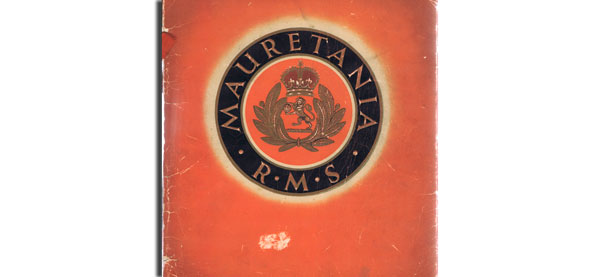Description
Athough somewhat distressed by time, this sumptuously produced brochure remains a wonderful example of high art deco style.
The second Mauretania was built by Cammell Laird of Birkenhead. She was the first new ship delivered to the combined Cunard White Star Line. On the withdrawal of the first Mauretania in 1934, in order to prevent a rival company using the name and to keep it available for the new liner, arrangements were made for the Red Funnel paddle steamer Queen to be renamed Mauretania in the interim.
Mauretania was laid down on 24 May 1937 as Yard Number 1029. This new medium sized Cunarder was launched on 28 July 1938 by Lady Bates, wife of the Cunard White Star chairman. She was named Mauretania to honour the previous record breaking Mauretania which had been retired in 1935. The ship was designed for the London to New York service and was the largest vessel ever to navigate the River Thames and use the Royal Docks. She was also intended to stand in for one of the Cunard Queens when they were undergoing maintenance.
The new liner had a tonnage of 35,739 gross, an overall length of 772 feet (235 m) and a beam of 89 feet (27 m) and had a exterior design similar to the much bigger Queen Elizabeth, being built on the Clyde. The vessel was powered by two sets of Parsons single reduction-geared steam turbines giving 42,000 shaft horsepower and driving twin propellers. Her service speed was 23 knots (43 km/h) with a maximum speed of 26 knots. Mauretania sailed on her maiden voyage from Liverpool to New York on 17 June 1939. After remaining in New York for a week she returned to Southampton via Cherbourg on Friday, 30 June 1939. Mauretania was to experience only the briefest period of commercial operation before the outbreak of hostilities. Returning from the next voyage, Mauretania called at Southampton, Le Havre and finally London where she berthed in the King George V Dock. From August she was switched to the London- New York service for which she was intended to rotate with the Britannic and Georgic.
On 11 August 1939 she left on her final prewar voyage to New York. On her return she was requisitioned by the Government, and in 1940, painted grey, she began an adventurous and useful life as a troopship. After the war, she relieved the Queens on the Southampton – New York services, cruising from that port to the West Indies or the Mediterranean during the winter
She was withdrawn in 1965.
PREVIEW BELOW – MAY TAKE A WHILE TO LOAD.

Reviews
There are no reviews yet.